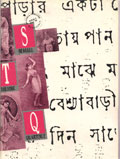May 1995. Editor: Anjum Katyal
Contemporary theatre reality in this country encompasses widely differing languages, styles, performative and economic circumstances, aims, philosophies and ideologies, which coexist, sometimes uneasily, sometimes feeding into and off one another. In a situation where theatre theories and practice are so widely divergent, it becomes especially important for a theatre journal to commit itself to flexibility and inclusiveness, to openness and variety. For me, this fifth issue perfectly reflects this variety: An exploration of Bengali theatre journals of the early 20th century shows up how a generation grappling with modernity coped with the new concept of women on the public stage; and the largely fictitious 'testimonials' and confessional narratives of 'actresses' quoted in it contrast interestingly with the authentic oral history that follows. Dina Pathak's 'first person' narrative is part of a series generated by STQ in which the attempt is to capture the voices of theatre persons who have lived through historically significant trends, periods and movements in which they have participated actively. Throughout the compelling narration with which Dina Pathak took us with her into her past, she would keep pausing to say-especially when speaking of very personal memories-I'm talking of this because it is part of what made me what I am today. Those particular experiences, those historical developments, those visual images and memories, all came together to 'construct' her theatre identity. The process of construction is also the central concern of Rimli Bhattacharya's essay, which dissects the configuration of the 'Acting Woman' in Bengali theatre journals of the early 20th century. These are two very different kinds of histories, which open up the complexities of demarcating what is private (or personal) and what is public. Moving from histories to ongoing processes, we have an account of a workshop with Clive Barker, whose theatre games should interest actors; and an interview with theatre designer M. Natesh. By way of proving how theatre ideas can travel successfully, Erin Mee describes how she used Kerala theatre techniques in her recent production of Timon of Athens in New York.
CONTENTS Actress Stories And The 'Female' Confessional Voice In Bengali Theatre Magazines (1910-1925) Rimli Bhattacharya 'But I am still here, acting and acting and acting...' Dina Pathak Theatre Games: A Workshop with Clive Barker Ramanjit Kaur Adding Texture to text: Kerala Theatrical techniques in Shakespeare's Timon of Athens Erin B. Mee 'Each set is a piece of sculpture for me' M. Natesh Theatre Log An Evening of Children's Plays Pawan Dhall Bangalore Little Theatre: Thirty Five Years of Community Theatre Vijay Padaki Celebrating International Women's Day in Calcutta Jhuma Basak Notebook Letters
Download the complete issue here
